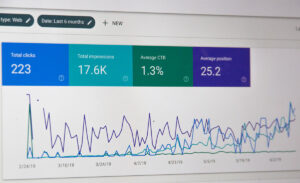What Is Search Engine Optimization (SEO) and How Does it Work
By pinnacleadmin / 27 April 2023 / SEO / 17 min read
What Is Search Engine Optimization?
Search engine optimization (SEO) is the practice of optimizing websites or online content to increase its visibility on search engine results pages (SERPs). SEO is an integral component of digital marketing as it attracts more traffic to websites, increases brand recognition, and boosts conversion rates. In this article, we’ll review its fundamentals – its importance, key components and best practices will all be covered here.

Why Is SEO Essential?
SEO is crucial because it increases website visibility and ranking on search engine results pages such as Google. When someone conducts a search using a search engine like Google, its algorithm ranks websites based on factors like relevance, authority and user experience; optimized websites often rank higher because search engines favour websites optimized specifically for them, which leads to increased traffic, brand recognition and conversions.
Key Elements of SEO
Website owners and digital marketers must understand a few essential components of SEO:
- Keyword Research: Keyword research refers to identifying relevant words and phrases people are searching for on search engines, to gain an understanding of what their target audience is searching for and how best to optimize content to rank for those keywords. It is vital for website owners in order to optimize content to reach those searching for information via search engines.
- On-Page Optimization: On-page optimization refers to optimizing individual website pages so as to increase their ranking on search engine results pages. This may involve making adjustments to their titles, meta descriptions, heading tags and content to target specific keywords for optimal SEO performance.
- Off-Page Optimization: Off-page optimization refers to any outside factors that have an effect on a website’s search engine results pages, such as link building or social media marketing campaigns that improve its online reputation or authority. It includes link development as well as strategies aimed at strengthening its online standing and reputation.
- Technical SEO: Technical SEO (Search Engine Optimization) refers to optimizing technical aspects of websites to increase their performance and search engine results pages (SERPs). Optimizations may include speed, mobile-friendliness and site architecture optimizations – see Best Practices for SEO for more details.
Here are a few best practices for SEO that website owners and digital marketers should abide by:
- Produce Quality Content: Quality, engaging content is vital to SEO success, so website owners must create articles with real value for their target audiences that can also optimize keywords effectively.
- Utilize Relevant Keywords: Incorporating relevant keywords throughout their content can increase its visibility and ranking on search engine results pages, but avoid keyword stuffing, the practice of overusing too many keywords within one piece of text.
- Optimize Metadata: Metadata should be optimized with targeted keywords in mind to provide an accurate and detailed account of page’s content.
- Gain Quality Backlinks: Integrating quality backlinks from high-authority sites can significantly strengthen a website’s online reputation and authority, potentially leading to better search engine results pages rankings.
- Evaluate Website Performance: Website owners and digital marketers should regularly assess their website’s performance using tools like Google Analytics to track traffic, engagement, conversions, areas for improvement and adjust SEO strategies accordingly. This data can provide invaluable insight for adjusting SEO strategies accordingly.
Search engine optimization (SEO) is an integral component of digital marketing that enables website owners and digital marketers to improve the visibility and ranking of their website on search engine results pages. By following key elements and best practices associated with SEO, website owners can increase traffic to their online presence as well as build brand recognition and conversions. Below we explore how SEO works further in detail.
Crawl Accessibility
Crawl accessibility refers to how easily search engine crawlers can access and read the content on your website. Search engine crawlers use complex algorithms to index web pages; if they cannot crawl a page for whatever reason, it won’t appear in search results, thus having an adverse impact on both visibility and traffic of your website.
Here are a few key factors that impact crawl accessibility:
- Robots.txt File:
A robots.txt file instructs search engine crawlers which pages they should crawl, and which to ignore. Without one on your website or with blocking pages that prevent crawlers from accessing important pages, this can prevent crawlers from accessing your content.
- Sitemap:
A sitemap is a file that lists all of your website pages in their hierarchical structure, making it easier for search engine crawlers to understand its layout and find your pages more quickly.
- URL Structure:
Your website’s URL structure should be clear and straightforward. Long or complex URIs that include too many parameters could confuse search engine crawlers and make content accessing difficult for searchers.
- Navigation:
Search engine crawlers follow links between pages, so if your navigation is confusing, they may not be able to fully index all your pages.
- Site Speed:
Site speed is an integral component of crawl accessibility. If your website takes too long to load, search engine crawlers may not be able to index all of its pages before timeout occurs and they get frustrated and leave.
- Content Accessibility:
Your website content must be easily readable by search engine crawlers, which means avoiding tactics such as hiding it behind images or Flash animations that cannot be read by them.
To ensure crawl accessibility, website owners and digital marketers should conduct regular audits of their website to identify any obstacles preventing search engine spiders from accessing content. Tools like Google Search Console can provide valuable insight into errors that impede access and other issues affecting visibility on search engine results pages; by addressing crawl accessibility issues website owners can ensure their content remains visible to search engine users thereby increasing traffic, engagement, and conversion rates on their website.
Create engaging content
SEO begins with producing compelling, user-centric content that directly answers searcher’s queries. Users who enter search queries typically seek solutions for their questions or problems that the results pages fail to offer, by creating relevant and interesting material directly addressing these queries your site can increase its search engine results page rankings and attract more qualified traffic.
Here are some helpful strategies for developing engaging content that responds directly to searcher’s inquiries:
- Conduct Keyword Research:
Before producing any content, conducting keyword research to understand what your target audience is searching for is vitally important. By using keyword research tools, it’s possible to quickly locate the most pertinent and high-traffic keywords related to your business or industry.
- Understand User Intent:
Once you’ve identified relevant keywords, it is critical to understand their user intent. Are users searching for information, products, or services? By understanding user intent and tailoring content specifically toward it, you can develop solutions which address their needs directly and provide real value to visitors.
- Develop High-Quality Content:
When crafting content, strive for quality over quantity. Ensure it’s well written, informative and engaging by using headers, subheadings and bullet points to break up text and make reading easier.
- Integrate Images and Videos:
Including high-quality, relevant images and videos can enhance the engagement of your content while strengthening its message. Be sure that any media used fits well into its overall theme.
- Optimize for Search Engines:
Producing content tailored specifically for your audience is of course paramount; but optimizing it for search engines should not be overlooked either. Use relevant keywords throughout your content with headlines and subheaders featuring them, making sure it’s easy for readers to navigate, using meta descriptions/title tags as needed so search engines understand its contents more readily.
By creating content that answers a searcher’s query, you can increase your website’s visibility on search engine results pages and draw in qualified traffic. Focusing on quality, relevance and optimization is essential to creating engaging material that not only ranks better in the SERPs but also delivers tangible solutions for target audiences.
Keyword Optimization
Optimizing your website content to include relevant keywords can be an essential element of Search Engine Optimization (SEO). By targeting specific keyphrases with SEO content optimization techniques, you can draw both searchers and search engines alike to your site. Below are some tips for keyword optimization:
- Conduct Keyword Research: To optimize keywords effectively, the first step should be conducting keyword research. Using various tools available online for this task, identify relevant and high-traffic keywords related to your business or industry and use long-tail keywords, which are longer phrases less competitive but targeted directly toward your audience.
- Utilizing Keywords in Headlines and Subheadings: Incorporating target keywords into headlines and subheadings will enable search engines to understand the content of your pages more readily. Create engaging headlines that accurately reflect what’s on offer on each page.
- Implement Keywords into Content: It is important not to overuse your target keywords when writing content, aiming for a keyword density between 1-2%. Attempt using variants of them so as to make your writing more natural and engaging.
- Integrate Keywords into Image Alt Tags: Utilizing target keywords as alt tags on images will allow search engines to better comprehend your pages’ content, while simultaneously providing accessibility benefits to screen reader users.
- Add Keywords to Meta Descriptions and Title Tags: Including target keywords in meta descriptions and title tags is one way of helping search engines understand the content of your pages, so make sure they accurately represent its contents while being appealing to users.
- Internal Linking: Internal linking can help search engines understand the structure and hierarchy of your website, with relevant anchor text containing target keywords to assist search engines in understanding your pages’ content.
By optimizing your website content for relevant keywords, you can draw search engines as well as visitors directly to it. Implementing target keywords in headlines, content, meta descriptions and internal linking, can increase its visibility on search engine results pages and draw in qualified traffic. However, make sure that keyword optimization doesn’t come at the cost of quality content or user experience, to ensure it serves its intended target audience well.
Excellent User Experience
In addition to crawl accessibility and keyword optimization, an outstanding user experience (UX) is vital for search engine optimization (SEO). Search engines strive to give their users the best results available and therefore favor websites which deliver an exceptional UX. Here are some strategies for improving the user experience on your website:
- Fast Load Speed: For an exceptional user experience, fast load times are essential. Users expect websites to load quickly while search engines prioritize faster-loading websites in their results pages. Tools like Google PageSpeed Insights can help test and evaluate your load speed to identify areas for improvement.
- Responsive Design: With more and more visitors accessing websites through mobile devices, responsive designs that adapt to various screen sizes are crucial. Not only can responsive designs enhance user experience and search engine rankings by adapting seamlessly, they may also lead to Google ranking sites more highly when ranking search engine results for mobile-friendly sites.
- Easy Navigation: Make sure your website is user-friendly by offering clear menus and hierarchies, so visitors can find what they’re searching for quickly without clicking through multiple pages.
- Clear Call-To-Actions (CTAs): Use clear and prominent calls-to-action (CTAs) to guide users through your website and encourage them to take the next step – filling out a contact form, subscribing to newsletter, making a purchase… Whatever it may be. Make sure your CTAs are easy to find so users don’t get confused or disoriented!
- Engaging Design: Engaging design can draw in users while reinforcing your brand identity. Use high-quality images and videos, engaging typography, and an appealing color scheme to create visually attractive websites that draw in users.
By offering an amazing user experience that includes fast load speed, responsive design, easy navigation, clear call-to-actions (CTAs), and engaging design elements, you can increase website visibility on search engine results pages and increase qualified traffic. An engaging experience not only builds trust with visitors to your site, but it can encourage further interaction and engagement from them.
Earning links and citations
One of the best ways to improve your search engine optimization (SEO) is securing links and citations from other websites, which requires creating high-quality, share-worthy content that other websites will want to link back to and cite as sources. Here are some strategies for producing such content:
- Provide Value: At its core, share-worthy content should provide real value to its audience. Whether its educational, entertaining or inspiring nature – whatever form it may take – should make an impressionful statement about you as a provider that your viewers find compelling and interesting.
- Original Research: Conducting original research can be an excellent way to gain links and citations from other websites. Publishing the results can establish your site as an authority on a topic within its industry, drawing interest from other media outlets as well as your peers in academia.
- Infographics and Visual Content: Infographics are highly shareable pieces, being easy to read and visually engaging. Use data and statistics to craft captivating infographics that other websites and users will want to link back to.
- Listicles and How-to Guides: Listicles and how-to guides are popular forms of shareable content due to their ease of reading and actionable advice they offer readers. Use your expertise to craft guides that deliver value for your audience.
- Guest Blogging: Guest blogging on other websites can be an effective way of earning links and citations back to your own. By contributing high-quality, informative posts to these platforms, you can establish yourself as a thought leader while drawing in readers from both sites and users alike.
By crafting engaging, share-worthy content that provides value for your audience, you can attract links and citations from other websites that can increase search engine results pages visibility while driving qualified traffic directly to your website. However, when it comes to earning links and citations it’s essential that quality over quantity is prioritized when it comes to earning links; few high-quality links from authoritative sites are far more valuable than multiple low-quality ones from irrelevant or spammy ones.
Schema Markup and Snippets
Snippet/schema Markup Along with creating fantastic content and optimizing it for search engines, another effective way to make your site stand out in search engine results pages (SERPs) is using snippet/schema markup. Snippet/schema markup refers to code added directly into HTML that provides search engines with additional details regarding your content that can be displayed as search results; helping it stand out and gain more clicks for your website. Below are a few types of snippet/schema markup that may prove especially effective:
- Rich Snippets: Rich snippets add additional information to search results, such as star ratings, reviews, prices and other details that help make your website stand out while giving users more context before clicking through to it. This provides users with additional insight about your content before they decide whether or not they want to click.
- Breadcrumbs: Breadcrumbs offer users an easier way to navigate your website and understand where they stand in its hierarchy. They can be displayed prominently within search results pages for an enhanced visual experience and easier navigation experience.
- Site Links: When used effectively, site links provide users with additional means for navigating your website. These extra options are especially valuable on large websites with multiple pages as they help users quickly and efficiently locate what they’re searching for.
- Organization Schema: Organization schema provides essential details about your organization, such as its name, logo and contact info. This data can then be displayed prominently in search results so users can more easily locate your website and reach out should any assistance be required.
Utilizing snippet/schema markup can make your website stand out in search engine results pages while offering users more information before they click through, increasing clicks, traffic, and ultimately SEO rankings. However, be mindful of using it incorrectly or against search engine guidelines, as any misuse may lead to penalties or exclusion from search engine results pages altogether.
Measuring SEO Performance
Measuring the performance of your SEO efforts is vital to understanding their effectiveness and making data-driven decisions that improve search engine visibility of websites. Below are key metrics and tools you can use to assess SEO performance:
- Organic Traffic: Organic traffic refers to visitors to your website who came directly through search engines like Google or Bing, such as using Google Analytics or another web analytics tool like Webtrends Pro. By monitoring changes over time in organic traffic volumes you can assess the success of SEO initiatives and their efforts.
- Keyword Rankings: Keyword rankings refer to your website’s position in search engine results pages for specific keywords. Tracking these rankings with tools like Google Search Console, Ahrefs or SEMrush allows you to assess how effective keyword targeting and optimization efforts have been over time.
- Backlinks: Backlinks refer to links from other websites pointing back to your own, providing authority and visibility benefits in search engine results pages. Tools like Ahrefs or Majestic can help track and monitor changes over time in your backlink profile.
- Click-Through Rates (CTRs): CTRs refer to the percentage of users who click your search result in search engine results pages, and can be tracked with tools like Google Search Console or web analytics software. By optimizing title tags, meta descriptions and other on-page elements for maximum effectiveness you can increase CTRs and drive more visitors directly to your website.
- Conversions: Conversions refer to any action visitors take while visiting your website, such as filling out a contact form, making a purchase, or downloading resources. By monitoring conversions with tools such as Google Analytics and assessing their effectiveness as indicators of conversion rate optimization efforts (CRO), tracking conversions enables you to make data-driven decisions to enhance user experience and increase conversions.
By tracking SEO metrics with tools such as Google Analytics, Search Console, Ahrefs and SEMrush you can measure the success of your SEO efforts and make data-driven decisions to increase search engine visibility and attract qualified traffic to your website. It’s essential that these metrics be tracked continuously over time with benchmark goals set so as to continuously optimize SEO strategy over time.
Web fingerprinting is an SEO monitoring technique that involves tracking changes in code, content and other elements over time. This practice helps SEO professionals keep an eye on both their own websites as well as competitive ones and use data-driven decisions to increase search engine visibility and drive more traffic towards these platforms.
There are various web fingerprinting tools available that can assist in SEO monitoring, including:
- Wayback Machine: The Wayback Machine is an Internet archive that enables users to view archived versions of websites over time, making it useful for monitoring changes to a site’s code and content as well as identifying any potential SEO issues or opportunities.
- Wappalyzer: Wappalyzer is a browser extension that enables users to identify the technologies and tools utilized by a website, including content management systems (CMS), analytics tools and advertising networks. This can be beneficial when looking for potential SEO opportunities as well as understanding competitors’ strategies.
- BuiltWith: BuiltWith is an online tool designed to identify the technologies and tools utilized by websites, similar to Wappalyzer; however, BuiltWith also provides additional details such as server information, SSL certificates, and email hosting providers.
- SEMrush: SEMrush is an advanced SEO tool with web fingerprinting features that allows it to identify changes to a website’s code or content, track keyword rankings and monitor backlinks – among other functions.
SEO professionals can use web fingerprinting tools like these to monitor both their own and competitors’ websites, and make data-driven decisions to increase search engine visibility and drive more traffic to them. But, for these tools to work properly and ethically – without incurring penalties or exclusion from search results pages – proper use is paramount.
Web Finger Prints is another tool we offer that monitors rankings on Google and Bing and shows complete history for every keyword term. Plus, it integrates seamlessly with Google Analytics 4 and search console so you only need one login for all the data that’s important to your success!
SEO provides insights into your website backlink profile so you can assess external links leading to it. For further information about how SEO can boost website rankings and generate more sales or enquiries, contact us.








